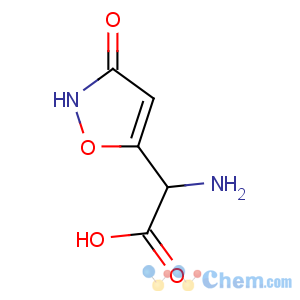Title: Ibotenic Acid
CAS Registry Number: 2552-55-8
CAS Name: a-Amino-2,3-dihydro-3-oxo-5-isoxazoleacetic acid
Synonyms: a-amino-3-hydroxy-5-isoxazoleacetic acid; amino-(3-hydroxy-5-isoxazolyl)acetic acid
Molecular Formula: C5H6N2O4
Molecular Weight: 158.11
Percent Composition: C 37.98%, H 3.82%, N 17.72%, O 40.48%
Literature References: Fly-killing and narcosis-potentiating amino acid structurally similar to kainic acid,
q.v., extracted from poisonous mushroom species. Isoln from
Amanita pantherina (DC.) Fr., and
A. muscaria (L.) Fr.,
Agaricaceae: Takemoto
et al., J. Pharm. Soc. Jpn. 84, 1233 (1964); Eugster
et al., Tetrahedron Lett. 1965, 1813. Structure: Takemoto
et al., J. Pharm. Soc. Jpn. 84, 1186, 1232 (1964). Syntheses: Gagneux
et al., Tetrahedron Lett. 1965, 2081; Sirakawa
et al., Chem. Pharm. Bull. 14, 89 (1966); Kishida
et al., ibid. 14, 92 (1966);
15, 1025 (1967). Improved synthesis: Nakamura,
ibid. 19, 46 (1971). Industrial pats:
BE 665249 C.A. 65, 2266e (1966); Gagneux
et al., US 3459862 (1965, 1969 both to Geigy); Kishida
et al., JP 68 15975;
JP 69 25780 (1968, 1969 both to Sankyo),
C.A. 70, 77944p (1969);
72, 13054g (1970). Pharmacology: Theobald
et al., Arzneim.-Forsch. 18, 311 (1968); Johnston
et al., Biochem. Pharmacol. 17, 2488 (1968). Exhibits potent neuroexcitatory activity:
eidem, Nature 248, 804 (1974). Chemistry review: Eugster,
Fortschr. Chem. Org. Naturst. 27, 261-321 (1969); Catalfomo, Eugster,
Bull. Narc. 22, 33-41 (1970). Excitatory and possible sedative actions on spinal neurons: D. R. Curtis
et al., J. Physiol. 291, 19 (1979); in cerebral cortex: E. Puil,
Can. J. Physiol. Pharmacol. 59, 1025 (1981). Use as experimental neurotoxic agent: A. Contestabile
et al., Experientia 40, 524 (1984).
Properties: Crystals from water or methanol, mp 151-152° (anhydrous); mp 144-146° (monohydrate). LD50 in mice, rats (mg/kg): 15, 42 i.v.; 38, 129 orally (Theobald).
Melting point: mp 151-152° (anhydrous); mp 144-146° (monohydrate)
Toxicity data: LD50 in mice, rats (mg/kg): 15, 42 i.v.; 38, 129 orally (Theobald)
Use: Neurobiological tool.

